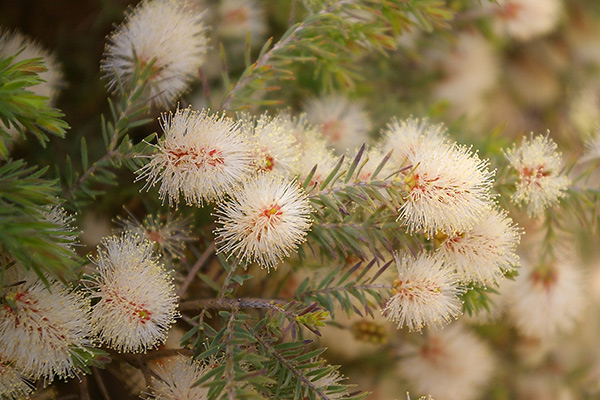Fuzzy-Leaf Paperbark
(Melaleuca incana incana)

Description
Melaleuca incana incana, commonly known as the Fuzzy-Leaf Paperbark, is a unique and fascinating plant species that belongs to the family Myrtaceae. This evergreen shrub is native to the coastal regions of Western Australia, where it thrives in sandy soils and is well-adapted to the harsh conditions of its natural habitat. Renowned for its distinctive foliage and attractive flowers, Melaleuca incana incana has gained popularity among gardeners and plant enthusiasts worldwide. In this article, we will explore the various aspects of this remarkable plant, including its taxonomy, morphology, habitat, cultivation, and uses. Taxonomy and Nomenclature Melaleuca incana incana is a subspecies of the broader species Melaleuca incana, which encompasses multiple recognized subspecies. The plant's scientific name is derived from the Greek words "melas" meaning "black" and "leukos" meaning "white," referring to the black stems and white flowers commonly found in the genus. The specific epithet "incana" refers to the plant's characteristic woolly or grayish pubescence, which covers its leaves and young branches, giving it a fuzzy appearance. The subspecies name "incana" further distinguishes it within the Melaleuca incana species. Morphology Melaleuca incana incana is a compact evergreen shrub that typically reaches a height of 1 to 2 meters (3 to 6.5 feet) with a similar spread. Its dense, bushy growth habit contributes to its ornamental value. The plant features a multi-stemmed structure, with numerous slender branches arising from a woody base. The bark of mature stems exhibits a papery texture and can peel off in thin layers, a characteristic common to many species in the Melaleuca genus. The most striking feature of Melaleuca incana incana is its leaves. The leaves are small, narrow, and elongated, measuring approximately 1 to 3 centimeters (0.4 to 1.2 inches) in length. They are arranged oppositely along the stems and are densely covered in fine, woolly hairs, which lend them their distinctive grayish or silvery appearance. These fuzzy leaves are responsible for the common name "Fuzzy-Leaf Paperbark." When crushed, the leaves emit a pleasant aroma, reminiscent of eucalyptus or tea tree. In addition to its foliage, Melaleuca incana incana produces attractive flowers. The flowers are generally white or cream-colored and are arranged in dense, cylindrical spikes at the tips of the branches. Each individual flower is composed of a papery calyx surrounding a cluster of stamens, giving the flower spike a fluffy appearance. The blooms are highly attractive to pollinators, such as bees and butterflies, and provide a delightful visual display during the flowering season. Habitat and Distribution Melaleuca incana incana is endemic to the coastal regions of southwestern Western Australia, where it occurs naturally in a range of habitats, including coastal dunes, sandy heaths, and shrublands. This subspecies has adapted to thrive in nutrient-poor soils and is well-suited to the sandy and often saline conditions found along the coast. Its natural distribution extends from Jurien Bay in the north to Cape Leeuwin in the south, encompassing a relatively small geographic range within Australia. Cultivation and Uses Due to its unique appearance and adaptability, Melaleuca incana incana has become a sought-after addition to gardens and landscapes. Here are some important considerations for the cultivation and uses of Melaleuca incana incana: Cultivation: Climate Requirements: Melaleuca incana incana thrives in a Mediterranean climate with mild, wet winters and warm, dry summers. It is best suited for USDA hardiness zones 9 to 11. Sunlight: This plant prefers full sun exposure, which promotes healthy growth and abundant flowering. Soil: Well-drained sandy soils are ideal for Melaleuca incana incana. The plant can tolerate slightly acidic to alkaline soils but dislikes waterlogged conditions. Watering: Once established, the Fuzzy-Leaf Paperbark is relatively drought-tolerant. It is important to provide regular water during the establishment phase, but excessive watering should be avoided to prevent root rot. Pruning: Prune the plant after flowering to maintain its shape and promote vigorous growth. Remove dead or damaged branches as needed. Landscaping and Garden Uses Ornamental Specimen: Melaleuca incana incana's unique fuzzy foliage and fluffy white flowers make it an attractive focal point in gardens and landscapes. Its compact size makes it suitable for both small and large garden spaces. Hedge or Border Planting: The dense growth habit and bushy nature of the plant make it an excellent choice for hedges or border plantings. It provides privacy, serves as a windbreak, and adds visual interest. Coastal Gardens: Given its natural habitat, Melaleuca incana incana is well-suited for coastal gardens due to its ability to tolerate sandy and saline conditions. Container Planting: The plant's compact size and attractive foliage make it an appealing choice for container gardening on patios, balconies, or courtyards. Ecological Importance Melaleuca incana incana, like other species in the Melaleuca genus, plays a vital role in the ecosystem. It provides habitat and food sources for various pollinators, including bees, butterflies, and nectar-feeding birds. The flowers' nectar serves as a valuable resource for these beneficial insects, contributing to the overall biodiversity of the area. Medicinal and Therapeutic Uses In traditional medicine, several Melaleuca species have been used for their medicinal properties. Although specific research on Melaleuca incana incana is limited, it is reasonable to assume that it shares some of the medicinal qualities of other Melaleuca species. The leaves and twigs contain essential oils known for their antimicrobial, antifungal, and anti-inflammatory properties. These oils have been utilized in topical treatments for skin ailments, minor cuts, and insect bites. Conclusion Melaleuca incana incana, with its fuzzy leaves, showy flowers, and adaptability to challenging coastal conditions, is a captivating addition to gardens and landscapes. Its unique characteristics, combined with its ecological importance and potential medicinal uses, make it an intriguing plant for both horticultural and conservation purposes. Whether as a focal point in a garden, a coastal hedging option, or a container plant on a patio, Melaleuca incana incana brings beauty and resilience to any setting fortunate enough to accommodate its presence.
Taxonomic tree:







